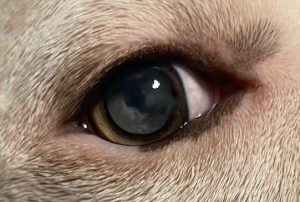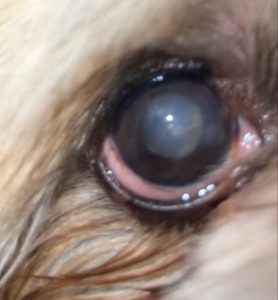A cataract is an opacity or clouding of the lens of the eye. Cataracts are variable in size. They can appear in older dogs as well as in younger dogs. Over time, cataracts cause loss of vision and eventually blindness.
Cataracts are not only an old age condition. They can lead to inflammation within the eye (uveitis) and other complications like glaucoma. Reach out to a vet if you see your dog’s eye becoming cloudy.
Overview
What are cataracts and how do they develop?
- Inside the eye, there is a lens that focuses light on the back of the eye (retina).
- Vision occurs at the retina.
- The lens should be crystal clear.
- Diseases of the lens, like cataracts, can change its transparency or clarity.
- A cloudy or opaque lens is called a cataract.
- There are different degrees of severity associated with how much of the lens is affected. Varying from too small to interfere with vision, to so large that impairs vision.
- A cataract can be classified as either incipient, immature, mature, or hypermature, according to its severity.
- The most common causes of cataracts are:
- Genetic
- Ageing
- Diabetes mellitus
- Other causes are: trauma, uveitis, lens luxation, and retinal disease.


Symptoms
What are the symptoms of cataracts in dogs?
- Cloudy or foggy appearance of the pupil.
- Reluctance to move, especially at night or in low-light conditions. This can be a sign of decreased vision.
Risk
Do some dogs have a higher risk of cataracts than others?
- Advanced age
- Diabetes mellitus
- Breeds with a high prevalence of cataracts: American cocker spaniel, Bichon Frise, Boston terrier, Miniature poodle, Standard poodle, Miniature schnauzer, and others.
- Genetic cataracts: Siberian huskies show a high prevalence of cataracts among young dogs (1-2 years of age).
Diagnosis
How are cataracts diagnosed?
Your vet will examine your dog’s eyes and use a light source to check for cataracts and determine their stage.
To help rule out any other conditions, your vet may recommend the following:
- Test the pressure inside the eye
- Dye test
- Tear production test
- Blood tests to check for other illnesses affecting the body and the eyes
Vet treatment
How can cataracts be treated?
Surgery is the only way to improve or remove cataracts. This type of surgery is typically performed by a vet who is specialised in ophthalmology.
Your dog can benefit from cataract surgery by gaining better eyesight and avoiding problems caused by long-term cataracts.
The ideal time to perform cataract surgery is usually prior to the cataract becoming mature (when the entire lens is involved).
There are currently no effective eye drop treatments that can delay or treat cataracts. You can discuss any treatment options with your ophthalmologist vet for more detailed information.
Home treatment
How to help a dog with cataracts at home?
- A dog with cataracts or vision loss usually adapts well to the environment at home.
- It is important to give blind dogs special attention, especially around hazards such as stairs, pools, and streets.
- When you have a blind dog, you should avoid moving furniture or any of your dog’s belongings, such as their food dish, water bowl or bed.
- Whenever your dog meets a new human or animal, they should be handled with extra care.
- Using a halo harness can be helpful for a blind dog.
What are the possible outcomes for a dog with cataracts?
Without surgical removal, cataracts may eventually cause blindness.
Cataracts can also cause other problems as they progress, including glaucoma and retinal detachment. Glaucoma can be painful and must be managed with eye drops.
Cataracts in diabetic dogs can form very quickly. Diabetic cataracts are caused by high blood sugar. Excess sugar (glucose) draws water into the lens. This causes the lens to swell, which results in cataracts. About 75-80% of diabetic dogs will develop cataracts within the first year of their diagnosis, regardless of how well-controlled their diabetes is.
Prevention
How can you help preserve your dog’s vision?
In most cases, you cannot prevent cataracts, but there are ways to ensure that your dog’s vision is preserved, especially if a medical condition like diabetes causes it.
These include:
- Checking your dog’s eyes regularly.
- Taking your dog to the vet if their eyes start to look cloudy.
- Taking your dog to the vet if you suspect they’re having trouble seeing.
- When possible, finding out the medical history of your dog’s parents, since cataracts are often inherited.
When to worry
When do you need to call a vet if your dog has cataracts?
If your dog shows any of the following signs call your vet:
- Sudden inability to see
- Squinting
- Redness of the eye
- Reluctant to open the affected eye or pawing at the face
Call us at Joii if:
- You have a blind dog and need help adjusting to their environment








